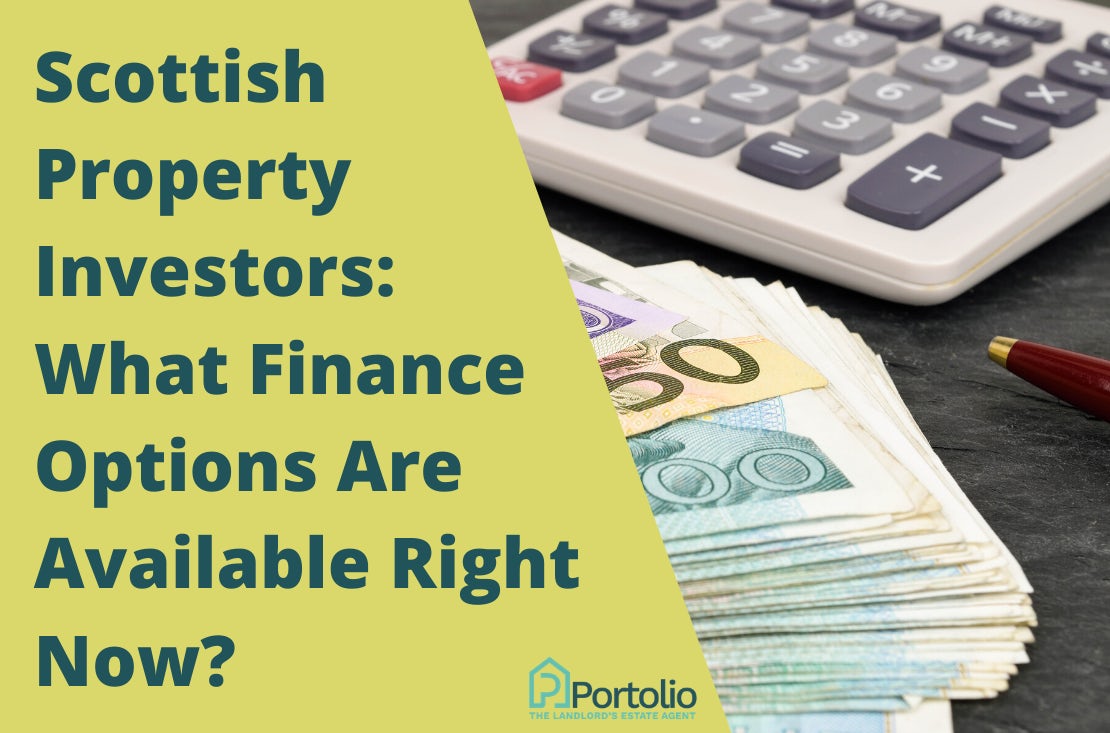Now that the market’s reopened, Scottish property investors are excited to get back into the game and continue to create revenue from property.
If that sounds anything like you, it’s always a good idea to get a better understanding of what your finance options are now – as it could be that you can afford more than you think!
TIP: It might also be worth checking out our blog about what to expect now that the market’s reopened, if you’re thinking about investing in property over the next few weeks and months.
So, whether you’re only just thinking of becoming a property investor for the first time, or you’re already a veteran when it comes to these things, I wanted to highlight some of the finance options available for Scottish property investors right now – and some things to watch out for.
Buy-to-let mortgages
In the past month, there have been some very positive signs that the buy-to-let mortgage market is already recovering, with BTL products increasing by 280, bringing the total number of mortgage options for landlords up to 1,735, according to Buy Association.
There’s also been a reduction in higher loan-to-value average rates, which is causing some experts (like us) to urge buy-to-let landlords to either expand their portfolios or remortgage now to take advantage of some of the great deals on offer.
There are now 26 two-year fixed rate 80% LTV deals on offer, and 20 more options for those interested in five-year fixed rates this June – with 100 new 75% LTV options now available (46 at two-year, and 54 at five-year fixed rates).
There’s also been a lot of chatter about 90% LTV loans, with the likes of HSBC still offering them. Some have been pulled temporarily (like Virgin), but it’s expected they’ll be coming back, along with those super low interest rates.
Eleanor Williams, finance expert at Moneyfacts (via Property Investor Today), said:
“Those looking to invest their money in property now that the mortgage market has reopened may feel it’s a good time to explore their options, particularly with rates becoming more competitive and product choice beginning to return this month.”
Bounce Back loan
Now, a controversial one. Over the past few weeks in our Property Pow Wows (over Zoom) we’ve heard about several landlords either applying or were interested in applying for the Scottish Government-backed ‘Bounce Back’ loan to use as finance to invest in property.
If you’re a landlord who has set up a limited company for your properties, you may be thinking this is a good idea. And technically there’s nothing from the Government saying you can’t use these loans for such a reason… but it does seem against the spirit of the Bounce Back loan, and lenders are taking a dim view of this.
Chris Sykes, mortgage consultant at Private Finance, told Mortgage Solutions: “Lenders have made it clear that bounce back loans should not be used to buy property, like a bank loan is rarely acceptable as a deposit for a property so are the bounce back loans – keyword here being loan.
“In fact, some lenders I have spoken to have been somewhat outraged by the fact we have asked them the question on a client’s behalf as the intended use of these loans isn’t to go and buy a property to profit from.”
That being said, some lenders will actually accept intercompany loans as a mortgage deposit, meaning they could pay the loan into one limited company, transferring it into the other, and then using it as a deposit to buy a property.
There’s also the option of giving yourself a dividend/salary from your company, and using that to pay the deposit – so, there are various ways around it. It’s just a bit of an iffy one that we’ll urge you to use your own discretion with.
A Bridge-to-Let loan
A Bridge-to-Let (or bridging loan) is a loan specifically designed for the buy-to-let market. They tend to be fixed term and are used to secure a property you want to rent out, but don’t have the basic mortgage or deposit you need yet – and are especially handy if you need to move fast.
Once you buy your investment property, you can then refinance using a more traditional buy-to-let mortgage, and moving in tenants who pay rent which will at least cover your mortgage payments.
TIP: You can read more of the finer details via lendinvest.com’s explanation about bridge-to-let loans
Dawn Walker, a specialist mortgage broker from The Right Advice, said: “For a lot of people, the nirvana is to have no money left in the deal. The Bridge-to-Let model reduces your total capital outlay when you work out all the money you pay out to buy, and the money you get back to refinance – so you recover your outlay at a faster rate.
“Bridge to Let doesn’t make sense on every deal, but it’s good for Scottish property investors who are able to buy low, refurbish, and refinance on a decent uplift in value. It’s also good for when you want to invest in a huge portfolio.”
So, what sort of strategy will you need if you’re looking to buy with a Bridge-to-Let loan?
Dawn said: “Ideally, you should be looking to buy low, and keep refurbishment costs reasonable (without adding too many expensive fixtures and fittings) so you’ll get a good uplift in value. It’s not an exact science, and you won’t get confirmation of how much you’ll get at the refinance from the refinance until the survey’s been completed.”
She continued: “Bridging is expensive, but luckily it also means the six-month requirement from lenders is waived, so you can move quickly, allowing you to get the refurbishment aspect completed in six weeks, and exit the bridge after just three months – moving onto your mortgage in month four, rather than the more traditional eight-month process if you were to pay in cash.”
Joint ventures
Maybe you don’t have the funds – or the desire – to purchase an investment property alone. And the good news is that you don’t have to. Joint venture agreements mean you can purchase an investment property with another party, or parties.
If you’re looking to buy an investment property to develop or renovate, and then sell for a profit, as part of a joint venture agreement with another party, it’s important that everyone involved has a very clear understanding of what’s expected of them, in terms of:
- The nature and scope of the project
- The goals each party has
- The roles and responsibilities each party agrees to
- The amount of input and control each party must have
- How the project is funded (it could be that you’re not bringing funds to the agreement at all, but some other form of value)
- Who is to be responsible for managing the project
- The timescale you both agree on to complete the project
- How any disagreements should be resolved (for instance, if neither party can agree on a sale price for the property)
- What happens if a party wishes to leave the joint venture
A detailed contract should be drawn up to lay out all of the above before a joint venture can even get off the ground, and it’s vital you don’t skip this step.
TIP: Check out the blog I wrote last year to learn more about joint ventures and discover whether they might be right for you.
Joint venture property deals can be an exciting – and rewarding – way to invest in property and see a good return on investment; as long as everyone plays their part and has a good idea of what that is. Choose your joint venture partner/s wisely, and happy investing!
Angel investors
If you’ve found your ideal next property project to work on, and you have more than an inkling you’ll see a great return on investment, but you don’t have the funds to get started… there is another option.
There is no shortage of angel investors around, if you know where to look. Angel investors can help you get that leg up when it comes to your next move in your property, and it’s actually very common for people to source money for investments this way.
There are mainly two main types of angel investor loans; secured against the purchase, or unsecured. Secured loans normally give the investor a 5% return on their investment once the deal has completed. With unsecured loans, it could be as much as 10%.
So, where do you find one of these angel investors? Well, they could be found in friends and family, private investors through your property contracts, online angel investor networks (of which there are many), crowdfunding platforms, or even through private wealth managers.
A way to start seeing immediate returns on your investment
If you’re looking to invest in property, buying an already tenanted property is another great way to make your money work for you, as it means you won’t have to worry about void periods whilst you find a tenant, or ensuring the property is let-ready – all of that is already in place.
In fact, you can even receive rental income on Day 1 of ownership.
Not all Scottish property investors know this is even an option, so we like to shout it from the rooftops whenever we can. With the right specialist estate agent, it’s actually fairly simple, and the tenancy agreement simply switches hands between the owners.
TIP: If you’d like to learn more about this way of investing, and to see if buying a tenanted property is the right option for you, you can read our recent blog (written with COVID-19 in mind).
Advice from the property pros
Like I mentioned above, money is cheap at the moment, so it’s a great time to get out there and make some savvy investments – even if it’s just a joint venture with someone else.
After all, (and I know we say this a lot) there’s nothing quite as solid as bricks and mortar when it comes to making long-term investments for the future – even when things around us might seem a little… uncertain at times.
If you’d like to learn more about purchasing a tenanted property, or even just want a little bit of extra advice to help decide which of the above finance options are right for you, I’d recommend getting in touch with a specialist estate agent (like us!) today.
They should be happy to listen to your long-term goals, and provide you with some impartial, no-strings advice.
To sum it up…
Thanks for reading. If you’re thinking of investing in property in the near future, hopefully the list has given you a better understanding of the options available for Scottish property investors at the moment.
There’s the obvious buy-to-let loans, the more controversial ‘bounce back’ loan – which may or may not be an option, depending on who you talk to and how you go about it – and lesser-known options, such as the Bridge-to-Let loan, joint ventures and angel investors.
However you decide to go about things, you may also want to think about whether you want to invest in an empty property (that you may have to put a bit of work into before getting tenants in), or an already tenanted property, allowing you to enjoy rental income from Day 1.
If you’d like to learn more about the options for Scottish property investors, why not get in touch with us today? We’d be happy to listen and give you some free, no-strings advice.
Finally; happy investing!
Written by Chris Wood, MD & Founder of Portolio
Get in touch on 07812 164 842 or email [email protected]


Comments